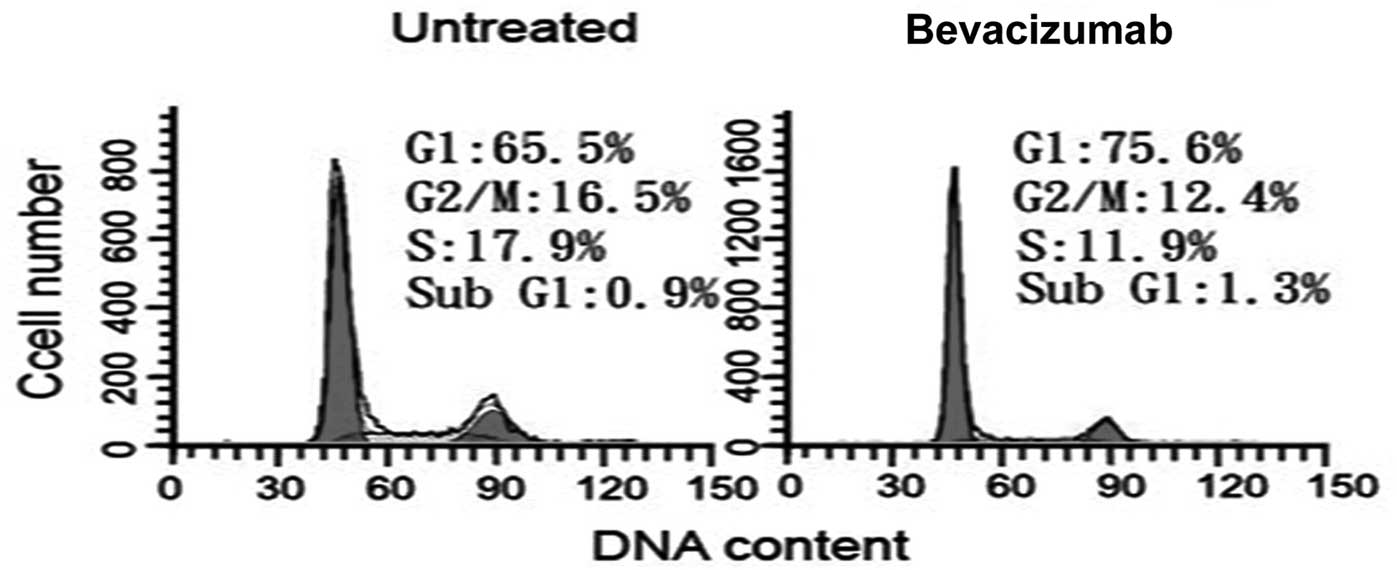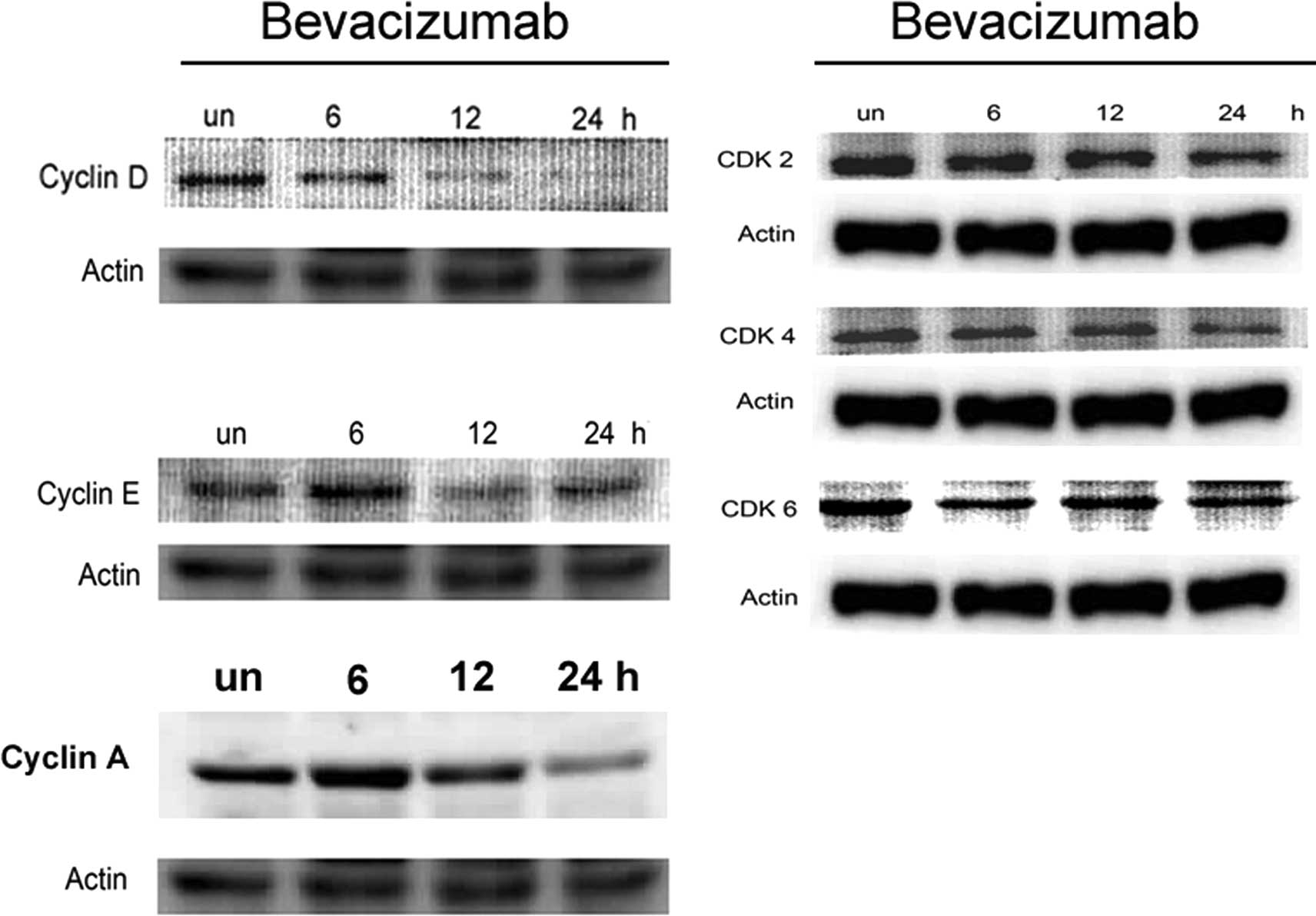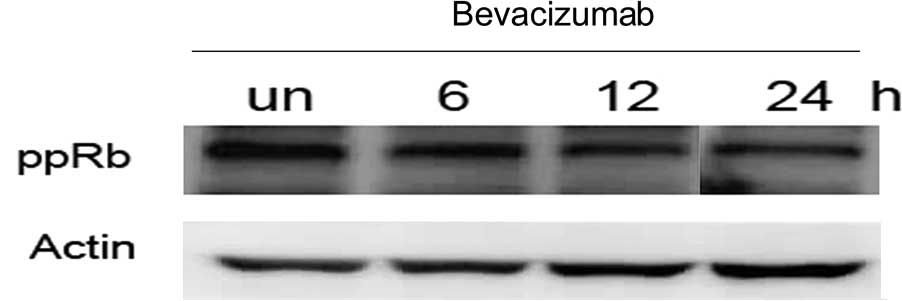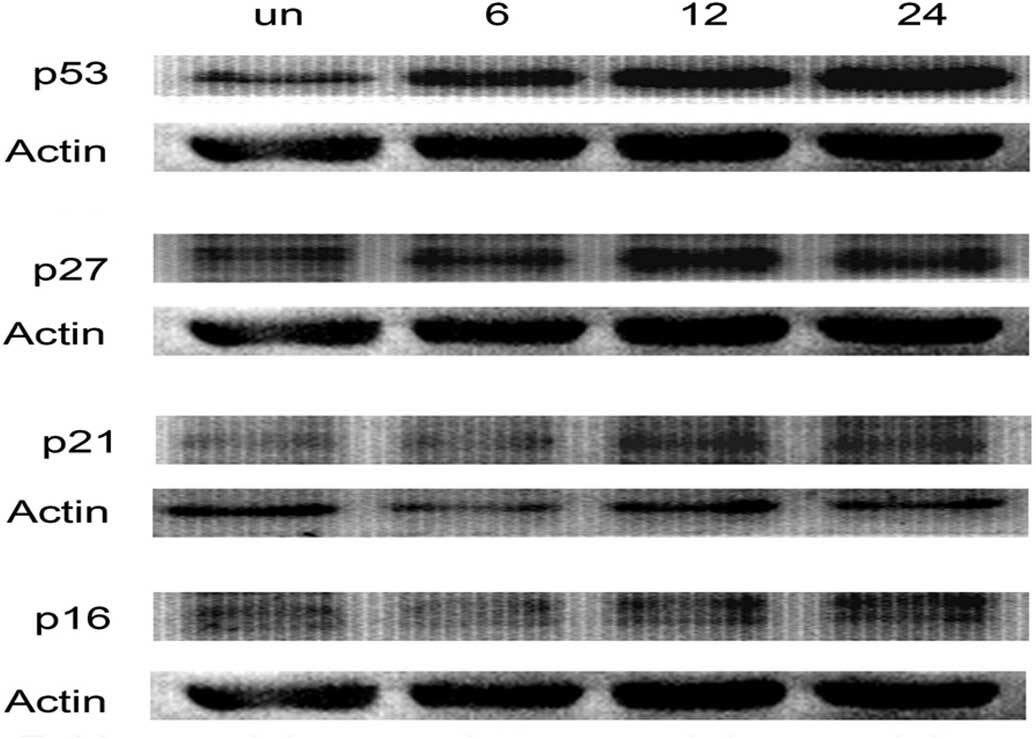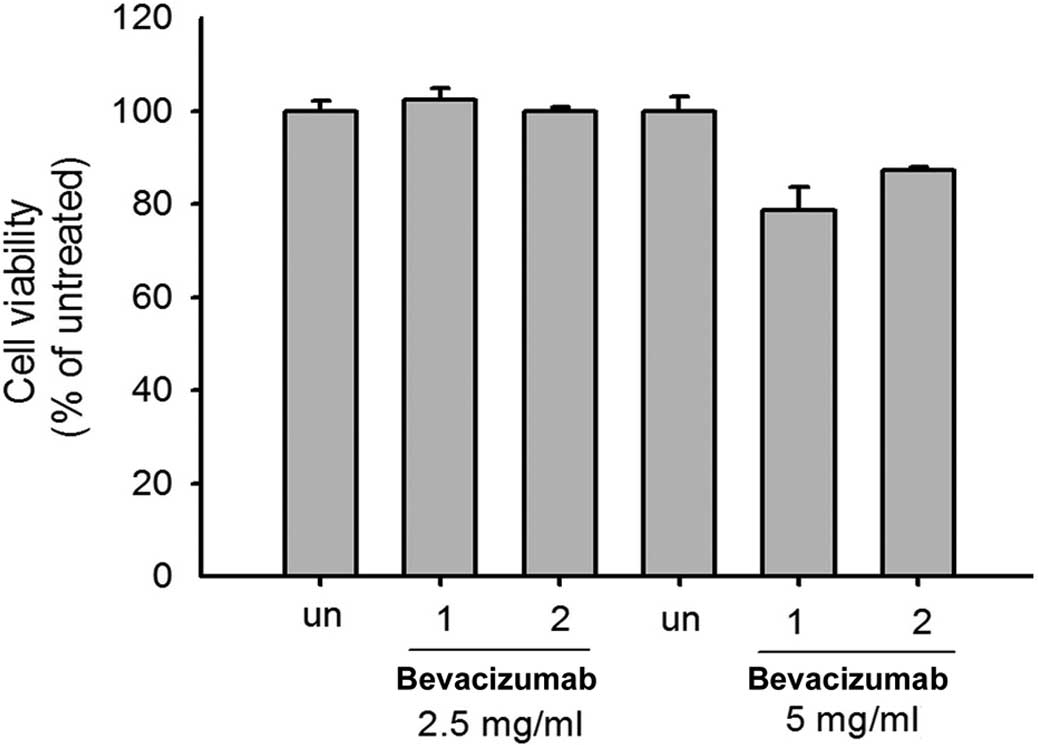Cell cycle regulation by bevacizumab in ARPE-19 human retinal pigment epithelial cells
- Authors:
- Published online on: July 11, 2012 https://doi.org/10.3892/mmr.2012.986
- Pages: 701-704
Abstract
Introduction
Bevacizumab (Avastin®; Genentech, San Francisco, CA, USA), a recombinant humanized monoclonal antibody, binds vascular endothelial growth factor (VEGF) and inhibits its interaction with receptors found on endothelial cells (1,2). Bevacizumab has been increasingly used as an off-label treatment for exudative age-related macular degeneration (AMD) (2). Retinal angiomatous proliferation, a variant of exudative neovascular AMD, has been described to occur in 3 stages: i) intraretinal neovascularization, ii) subretinal neovascularization with (stage IIB) or without (stage IIA) serous pigment epithelial detachment (PED) and iii) a vascularized PED with retinal-choroidal anastomosis (RCA) (3). The ocular complications of bevacizumab intravitreal injection included corneal abrasion, chemosis, lens injury, ocular inflammation, retinal pigment epithelial tear and acute vision loss. The systemic complications included cerebral infarction, elevation of systolic blood pressure, facial skin redness, itchy diffuse rash and menstrual irregularities (4). Another study demonstrated that retinal pigment epithelial (RPE) tears occur after intravitreal bevacizumab injections for exudative AMD in approximately 1.6% of the eyes and may cause severe vision loss. Intravitreal bevacizumab injections also cause RPE tears in patients with predominantly classic choroidal neovascularization (5). The serial intravitreal injection of bevacizumab caused a large retinal pigment epithelium rip resulting in a large fibrovascular pigment epithelial detachment (6). It has been hypothesized that intravitreal bevacizumab induces contraction of choroidal neovascular membranes, thus accelerating RPE tear development (2).
An in vitro study demonstrated that bevacizumab at a concentration of 2.5 mg/ml caused a moderate decrease in ARPE-19 cell numbers and cell viability after 2 days of treatment (7). Bevacizumab caused a dose-dependent suppression of DNA synthesis in pig choroidal endothelial (CEC) cells, as a result of a moderate antiproliferative activity (maximum reduction 36.8%). At higher doses (2.5 mg/ml) bevacizumab may be harmful to the retinal pigment epithelium (7). However, after 2 days at a bevacizumab concentration of 2.5 mg/ml, a moderate decrease in ARPE-19 cell numbers and cell viability was observed.
However, the mechanisms by which bevacizumab induced the cell cycle arrest in ARPE-19 cells has yet to be determined. The present study aimed to clarify the role of bevacizumab in the cell cycle and the effects of DNA synthesis on human ARPE-19 cells, as well as provide understanding of the molecular pathway of the function of bevacizumab in cell cycle regulation.
Materials and methods
Evaluation of the bevacizumab-induced cell cycle and DNA synthesis inhibition in human ARPE-19 cells
Cells were cultured in 60-mm tissue-culture dishes (8×105 cells/dish). The culture medium was replaced by a new medium after 24 h and subsequently exposed to 2.5 mg/ml bevacizumab for 48 h. After treatment, adherent and floating cells were pooled, washed with PBS, fixed in PBS-methanol (1:2 volume/volume) solution, and maintained at 4°C for at least 18 h. Following 2 more washes with PBS, the cell pellets were stained with the propidium iodide (PI) fluorescent probe solution containing PBS, 40 μg/ml PI, and 40 μg/ml DNase-free RNase A for 30 min at room temperature in the dark. DNA fluorescence of PI-stained cells was evaluated by excitation at 488 nm and monitored through a 630/22-nm band pass filter using flow cytometry. A minimum of 10,000 cells was analyzed per sample, and the DNA histograms were gated and further analyzed using Modfit software on a Mac workstation to estimate the percentages of cells in various phases of the cell cycle.
Evaluation of the bevacizumab-induced expression of cell cycle-regulated proteins in human ARPE-19 cells
ARPE-19 cells (1×106) were cultured in 60-mm tissue-culture dishes for 24 h. The culture medium was replaced with a new medium and exposed to bevacizumab for the indicated time points. After treatment, the cells were washed with PBS, re-suspended in a protein extraction buffer for 10 min and then centrifuged at 12,000 × g for 10 min at 40°C to obtain total extracted proteins (supernatant). The protein concentrations were measured usinga Bio-Rad protein assay reagent (Bio-Rad, Richmond, CA, USA). The expression of cell cycle-regulated proteins was evaluated by western blotting. Briefly, the total extracted proteins were boiled in loading buffer, and an aliquot corresponding to 50 μg of protein was separated by 12% SDS-polyacrylamide gel. After electrophoresis, the proteins were electrotransferred onto a polyvinylidene fluoride transfer membrane. The membranes were then incubated with the primary antibody of various cell cycle-regulated proteins overnight, and washed with PBST solution (0.05% Tween-20 in PBS). Following washing, the secondary antibody labeled with horseradish-peroxidase was adjacently incubated for 1 h, and washed with PBST solution (0.05% Tween-20 in PBS). The antigen-antibody complexes were detected by enhanced chemiluminescence (Amersham Pharmacia Biotech, Piscataway, NJ, USA) with a chemiluminescence analyzer.
Evaluation of the bevacizumab-induced cell viability in human ARPE-19 cells
ARPE-19 cells (8×105) were cultured in 60-mm tissue-culture dishes for 24 h. The culture medium was replaced with a new medium and then exposed to 0, 2.5 and 5.0 mg/ml of bevacizumab for 24 h. After treatment, the ARPE-19 cells were incubated for 2 h with 0.5 mg/ml of MTT reagent and lysed with DMSO. The absorbance was measured at 570 nm in a microplate reader.
Results
Bevacizumab induced G1/S phase arrest in ARPE-19 cells
We initially used PI staining and flow cytometry to evaluate whether bevacizumab is capable of disrupting the cell cycle progression. The G1 and S phases were 65.5 and 17.9% in untreated cells, respectively (Fig. 1). Treatment with 2.5 mg/ml bevacizumab resulted in a marked decrease in the S phase (11.9%) at 48 h, suggesting that bevacizumab inhibits DNA synthesis in ARPE-19 cells. The G1 phase increased slightly to 75.6% following treatment with bevacizumab, indicating a G1/S arrest during bevacizumab treatment in ARPE-19 cells.
Effect of bevacizumab on cell cycle regulatory proteins in ARPE-19 cells
Based on the observation that bevacizumab induced a G1/S arrest in ARPE-19 cells, we evaluated the effect of bevacizumab on cell cycle regulatory proteins that are important in G1/S cell cycle progression, using western blot analysis. As shown in Fig. 2A, bevacizumab treatment induced a decrease in the protein level of cyclin D in ARPE-19 cells that were clearly visible after 6, 12 and 48 h of treatment. The expression of cyclin E increased slightly after 6 h of treatment, followed by a marked upregulation after 12 and 24 h, compared with the untreated cells. Thus, the bevacizumab-mediated G1/S phase cell cycle arrest of ARPE-19 cells correlated with the inhibition of cyclin D and E. The bevacizumab-treated ARPE-19 cells also demonstrated a decrease in the protein levels of CDK2, 4 and 6 that was visible after 6, 12 and 24 h of treatment (Fig. 2B). Consistent with cyclin D and CDK4 downregulation, bevacizumab markedly inhibited the phosphorylation of pRb (ppRb) at 24 h (Fig. 3). Moreover, to gain further insights into the mechanism of bevacizumab-mediated G1/S phase arrest, we determined its effect on p53, p21, p16 and p27 protein expressions by immunoblotting. Bevacizumab treatment resulted in a time-dependent increase in the protein expressions of p53, p21, p16 and p27 in ARPE-19 cells (Fig. 4).
Bevacizumab inhibited cell viability in ARPE-19 cells
Our study demonstrated that bevacizumab at a concentration of 2.5 mg/ml in 24 h caused a moderate decrease of the G1/S phase in ARPE-19 cells (Fig. 1). The MTT assay was subsequently used to prove that bevacizumab (5.0 mg/ml) treatment inhibited the cell viability to 80% in ARPE-19 cells after 48 h (Fig. 5).
Discussion
Bevacizumab inhibited monkey choroidal endothelial cells at 2.0 mg/ml on cell viability, however, no effect was noted on the ARPE-19 and RGC-5 cell lines at 2.0 mg/ml (8). Results of that study are similar to our findings demonstrating that bevacizumab treatment did not reduce the cell viability at 2.5 mg/ml in ARPE-19 cells at 24 h. In the higher concentration of bevacizumab (5 mg/ml), cell viability was reduced to 80% suggesting that bevacizumab might affect the cell cycle of ARPE-19 cells. A recent study reported that bevacizumab has a cytostatic effect of VEGF inhibition on multiple myeloma. This malignancy of plasma cells was determined through the attenuation of critical signaling effectors: VEGF receptor 1, mTOR, c-Myc, Akt, STAT3 and eIF4E (9). In addition, bevacizumab has a direct effect on major pathways critically activated in multiple myeloma that is independent from its established effect on angiogenesis (9). These effects of bevacizumab were achieved using high concentrations (2 mg/ml). These results indicate that bevacizumab had a higher cytostatic effect on multiple myeloma, compared with the ARPE-19 and RGC-5 cell lines at 2 mg/ml.
CDK2, 4 and 6, as well as cyclins D and E, are various driving forces for the G1/S phase of the cell cycle (10). Therefore, significant decreases in the protein expression of cyclin D, E and A, as well as CDK2, 4 and 6 due to bevacizumab suggest a potential inhibition on ARPE-19 cell growth through cell cycle regulation (Fig. 2A and B). The upregulation of p53 at 0 and 48 h alone, with a marked induction of the expression of p16, p21 and p27 at 48 h was also observed (Fig. 2D). Moreover, the accumulation of p53 induces the upregulation of cell cycle-regulatory proteins, such as p21 and p27, whereas the induction of these genes leads to G0/G1 arrest (11).
Cyclins, such as type D and E regulate G1/S phase cell cycle progression through the activation of specific CDK that phosphorylates the pRb protein, thereby decreasing the repression of E2F-DP transactivation of S-phase genes (12). Loss of cyclin D causes G1 arrest in some cells, but in other cell lines, the downstream cyclin E protein replaces cyclin D and aids G1/S progression (13). In bevacizumab treatment, the expression of cyclin E increased slightly at 24 h in ARPE-19 cells (Fig. 2A). However, the downregulation of cyclin D1 started at 6 h and sustained to 24 h in bevacizumab treatment (Fig. 2A). This seems to explain the downregulation of cyclin D1, but not of cyclin E, and is a main factor for bevacizumab-induced G1/S arrest. Findings of another study also demonstrated that cyclin D1 degradation is sufficient to induce G1 cell cycle arrest despite the constitutive expression of cyclin E2 in ovarian cancer cells (12). CDKs are regulated by distinct protein sequences, including the cyclins required for the CDK activity and inhibitor (CKI) proteins (14). Results of the western blotting demonstrated that bevacizumab decreased cyclin D1 levels (Fig. 2A). The protein levels of CDK2, 4 and 6 were also inhibited by bevacizumab at 24 h (Fig. 2B). In addition, CKIs, such as p16, p21 and p27 were increased by bevacizumab, at least within a 6- to 24-h treatment period (Fig. 2D). Therefore, the inhibitory effect of bevacizumab on cell cycle-regulated proteins, not only inhibited the expression of cyclins/CDKs, but also promoted the expression of CKIs.
Factors associated with the Rb family proteins are recognized as determining downstream targets of G1-specific cyclin/CDK complexes (15). In hypophosphorylation, the Rb proteins correlate with and suppress the activity of E2F family transcription factors, which are involved in the transcription of key cell cycle-regulatory proteins (16). Upon growth stimulation, the G1-specific cyclins/CDKs phosphorylate Rb, resulting in the release of E2F factors and progression into the S phase (16). The phosphorylation of Rb provides a crucial role in the progression of the G1 phase and the transition of G1 to S phase (17). Ser795 in pRb is a specific site for phosphorylation by the cyclin D/CDK4 complex in the G0/G1 phase (18). The treatment with bevacizumab resulted in the inhibition of cyclin D and CDK4 expression in ARPE-19 cells, as well as the prevention of CDK4 from phosphorylating pRb at Ser795, thereby arresting cell growth (Fig. 2). Another study demonstrated that the p21 protein binds to cyclin/CDK complexes resulting in inhibition of the G1/S phase transition by inhibiting the phosphorylation of the Rb protein (19). The decrease in phosphorylated Rb proteins, therefore, might result from bevacizumab-triggered p21 expression and the decreased expression of cyclin-CDK. Generally, we observed that bevacizumab inhibited cell growth in ARPE-19 cells. We, therefore, suggest a novel pathway by which bevacizumab regulates cell cycle progression in ARPE-19 cells. Bevacizumab was able to induce p53 production, and then upregulate the expression of p16, p21 and p27. These events decrease the expression of cyclin D and E, and CDK2, 4 and CDK 6, followed by the reduction of ppRb as well as the triggering of the G1/S arrest of the cell cycle.
Acknowledgements
This study was supported by a grant from the Chang Gung Memorial Hospital, ROC: CMRPG6B0041.
References
|
Luthra S, Narayanan R, Marques LE, Chwa M, Kim DW, Dong J, Seigel GM, Neekhra A, Gramajo AL, Brown DJ, et al: Evaluation of in vitro effects of bevacizumab (Avastin) on retinal pigment epithelial, neurosensory retinal, and microvascular endothelial cells. Retina. 26:512–518. 2006.PubMed/NCBI | |
|
Garg S, Brod R, Kim D, Lane RG, Maguire J and Fischer D: Retinal pigment epithelial tears after intravitreal bevacizumab injection for exudative age-related macular degeneration. Clin Experiment Ophthalmol. 36:252–256. 2008. View Article : Google Scholar | |
|
Forooghian F, Cukras C and Chew EY: Retinal angiomatous proliferation complicated by pigment epithelial tear following intravitreal bevacizumab treatment. Can J Ophthalmol. 43:246–248. 2008. View Article : Google Scholar | |
|
Shima C, Sakaguchi H, Gomi F, Kamei M, Ikuno Y, Oshima Y, Sawa M, Tsujikawa M, Kusaka S and Tano Y: Complications in patients after intravitreal injection of bevacizumab. Acta Ophthalmol. 86:372–376. 2008. View Article : Google Scholar : PubMed/NCBI | |
|
Arias L, Caminal JM, Rubio M, Pujol O and Arruga J: Retinal pigment epithelial tears after intravitreal bevacizumab injection for predominantly classic choroidal neovascularization. Eur J Ophthalmol. 17:992–995. 2007. | |
|
Subramanyam A, Phatak S and Chudgar D: Large retinal pigment epithelium rip following serial intravitreal injection of avastin in a large fibrovascular pigment epithelial detachment. Indian J Ophthalmol. 55:483–486. 2007. View Article : Google Scholar | |
|
Spitzer MS, Wallenfels-Thilo B, Sierra A, Yoeruek E, Peters S, Henke-Fahle S, Bartz-Schmidt KU and Szurman P; Tuebingen Bevacizumab Study Group. Antiproliferative and cytotoxic properties of bevacizumab on different ocular cells. Br J Ophthalmol. 90:1316–1321. 2006. View Article : Google Scholar : PubMed/NCBI | |
|
Brar VS, Sharma RK, Murthy RK and Chalam KV: Evaluation of differential toxicity of varying doses of bevacizumab on retinal ganglion cells, retinal pigment epithelial cells, and vascular endothelial growth factor-enriched choroidal endothelial cells. J Ocul Pharmacol Ther. 25:507–511. 2009. View Article : Google Scholar | |
|
Attar-Schneider O, Drucker L, Zismanov V, Tartakover-Matalon S, Rashid G and Lishner M: Bevacizumab attenuates major signaling cascades and eIF4E translation initiation factor in multiple myeloma cells. Lab Invest. 92:178–190. 2012. View Article : Google Scholar | |
|
Mueller A, Odze R, Jenkins TD, Shahsesfaei A, Nakagawa H, Inomoto T and Rustgi AK: A transgenic mouse model with cyclin D1 overexpression results in cell cycle, epidermal growth factor receptor, and p53 abnormalities. Cancer Res. 57:5542–5549. 1997.PubMed/NCBI | |
|
Yoo YA, Kim MJ, Park JK, Chung Young Min, Jong HL, Sung-Gil C, Jun SK and Young DY: Mitochondrial ribosomal protein L41 suppresses cell growth in association with p53 and p27Kip1. Mol Cell Biol. 25:6603–6616. 2005. View Article : Google Scholar : PubMed/NCBI | |
|
Masamha CP and Benbrook DM: Cyclin D1 degradation is sufficient to induce G1 cell cycle arrest despite constitutive expression of cyclin E2 in ovarian cancer cells. Cancer Res. 69:6565–6572. 2009. View Article : Google Scholar : PubMed/NCBI | |
|
Yu Q, Geng Y and Sicinski P: Specific protection against breast cancers by cyclin D1 ablation. Nature. 411:1017–1021. 2001. View Article : Google Scholar : PubMed/NCBI | |
|
Sherr CJ and Roberts JM: Inhibitors of mammalian G1 cyclin-dependent kinases. Genes Dev. 9:1149–1163. 1995. View Article : Google Scholar : PubMed/NCBI | |
|
Sherr CJ: The Pezcoller lecture: cancer cell cycles revisited. Cancer Res. 60:3689–3695. 2000.PubMed/NCBI | |
|
Vivar OI, Lin C, Firestone GL and Bjeldanes LF: 3,3′-Diindolylmethane induces a G1 arrest in human prostate cancer cells irrespective of androgen receptor and p53 status. Biochem Pharmacol. 78:469–476. 2009. | |
|
Jinno S, Hung SC and Okayama H: Cell cycle start from quiescence controlled by tyrosine phosphorylation of Cdk4. Oncogene. 18:565–571. 1999. View Article : Google Scholar : PubMed/NCBI | |
|
Das SK, Hashimoto T and Kanazawa K: Growth inhibition of human hepatic carcinoma HepG2 cells by fucoxanthin is associated with down-regulation of cyclin D. Biochim Biophys Acta. 1780:743–749. 2008. View Article : Google Scholar : PubMed/NCBI | |
|
Ukomadu C and Dutta A: p21-dependent inhibition of colon cancer cell growth by mevastatin is independent of inhibition of G1 cyclin-dependent kinases. J Biol Chem. 278:43586–43594. 2003. View Article : Google Scholar : PubMed/NCBI |



